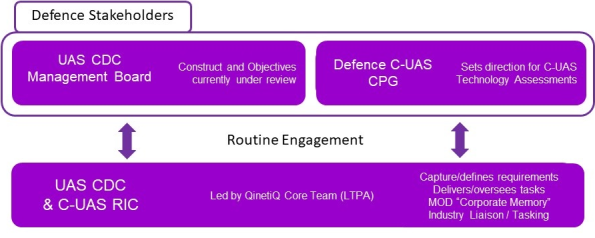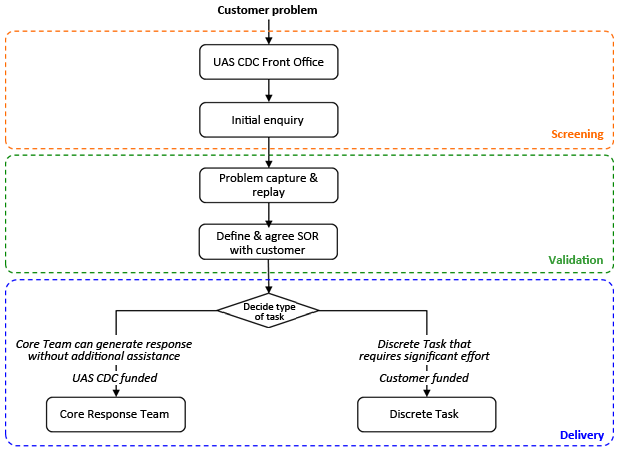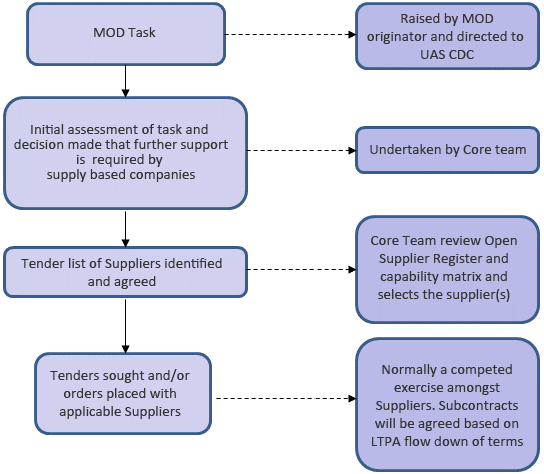Frequently Asked Questions
Governance
-
How is the UAS CDC run and governed?

-
What are the sources of funding?
The LTPA (under FMC WECA) is providing the underpinning support in the first instance. Emergent programmes and projects shall be funded as required, generally by the benefiting agency or programme.
-
Who decides what work gets done?
In considering work, the UAS CDC considers a review of “in scope or not” and “should we do it” and “what issues are not being addressed.” In addition, the UAS CDC considers whether the requested task in hand, if delivered by the UAS CDC, will deliver benefit to Defence. The next consideration is one of capacity and timeliness. For support to the C-UAS community, the UAS CDC’s C-UAS Rapid Innovation Cell (RIC) takes direction from the Defence C-UAS Capability Planning Group.
Objectives
-
What is UAS Capability Development in the context of the UAS CDC?
MOD recognises the need to develop UAS and C-UAS capability enablers and, in particular, the test & evaluation capabilities that enable development, demonstration, experimentation and operation of UAS and C-UAS technologies. The LTPA is established to deliver T&E enablers and the UAS CDC is a sub-set of that delivery.
-
What relationship will the UAS CDC have with OGD?
The UAS CDC continues to work with Other Government Departments, where appropriate and where benefit to Defence may be realised. This applies for both UAS and C-UAS interests.
-
Why is the UAS CDC at Boscombe Down?
The UAS CDC has an office at Boscombe Down but is presence at several locations across the UK. The UAS CDC has long-since recognised the need to be able to support Users, wherever they are based.
-
Things the UAS CDC is not, or does not do:
- Undertake work that is not UAS related
- Set policy
- A legal entity
Roles
-
What is QinetiQ’s role in the UAS CDC?
MOD is using its Long Term Partnering Agreement (LTPA) for Test & Evaluation and Training Support to task QinetiQ to facilitate the delivery of the UAS CDC on behalf of and in conjunction with MOD, Dstl and other stakeholders.
QinetiQ personnel within the UAS CDC are separated from QinetiQ’s other commercial and/or strategic concerns through application of Confidentiality Agreements. When the potential for Conflict of Interest is identified, arrangements are enacted in accordance with QinetiQ procedures which comply with the MOD’s Generic Compliance Regime. Additionally, in accord with normal business practice, QinetiQ’s performance and delivery within the UAS CDC is subject to appropriate business scrutiny and management to ensure consistent and appropriate levels of service and performance.
-
How does the UAS CDC validate customer requirements?
The UAS CDC uses the screening and validation processes set out in the diagram below.

Industry
-
How does Industry engage with the UAS CDC?
The UAS CDC is keen that Industry engages to support specific and emergent MOD issues/questions.
An Open Supplier Register (OSR) is established, providing the UAS CDC and its MOD stakeholders with a database of UAS and C-UAS capabilities as indicated by submissions from industry and organisations with UAS and C-UAS knowledge and expertise. The OSR is utilised as a starting point when compiling companies of interest in response to specific challenges or issues presented to the UAS CDC by its MOD stakeholders. Industry and other organisation with UAS and C-UAS knowledge and expertise are continuously encouraged to register on the OSR which may be done at any time and is a straight-forward process.
-
What is the process for work coming from the UAs CDC to industry and others?

-
How do I contribute ideas on future work activities for MOD/UAS CDC to consider?
The UAS CDC is interested in receiving proposals from Industry that would be of a demonstrable benefit to Defence; these could relate to training, test and evaluation or wider UAS enabler activity. Email in the first instance, please click here.
-
Is the UAS CDC only working with British industry?
The UAS CDC will always seek best value for UK Defence. Tasking opportunities will be competed amongst those companies on the Open Supplier Register who have the required capabilities.
-
Can QinetiQ bid for work from the UAS CDC?
Yes. The UAS CDC will consider the non-UAS CDC element of QinetiQ for tasking opportunities in the same way as other industry companies on the Open Supplier Register. QinetiQ will have no preferential benefit and will have to apply for inclusion in the Open Supplier Register as per industry companies.
-
What is the Open Supplier Register?
The Open Supplier Register (OSR) provides the UAS CDC with a database of UAS and C-UAS capabilities provided by industry and other organisations and will be used to compose tender lists.
-
What is meant by ‘Open’ in the Open Supplier Register?
Simply that industry companies not on the Open Supplier Register will be able to make an application to join the Open Supplier Register at any time. Please click here to register.
-
How do I express an interest in joining the Open Supplier Register?
Interested suppliers and organisation who wish to join the Open Supplier Register should submit their details for consideration by the UAS CDC. Please click here.
-
If successful in joining the Open Supplier Register, what guarantee do I have that I will receive any work through the UAS CDC?
No guarantee of work is provided.
Commercial
-
How do you/I protect my IP?
All participating members will be expected to sign-up to appropriate Non-Disclosure Agreements where applicable. Discrete work packages i.e. those contracted between industry and MOD directly, will be covered by standard DEFCONs in accord with current practice.
-
Who decides who gets the work?
Tasking opportunities requiring Industry support will be competed amongst those companies on the Open Supplier Register who have the required capabilities. An Expression of Interest (EOI) note will be issued to identified organisations who have indicated they have the required capability or expertise. Those responding positively to a received EOI will then be requested for costed proposals; proposals will be reviewed with the demanding MOD stakeholder. Where competitive tenders are sought, these will be objectively evaluated by the UAS CDC for review and direction from the demanding MOD stakeholder. The UAS CDC (QinetiQ) will award relevant subcontracts to Industry.
-
Between whom will the contracts exist?
Normally the MOD customer will let the contract(s) to the UAS CDC (QinetiQ) using the LTPA contracting vehicle and, where elements are to be subcontracted, the UAS CDC will let the subcontracts to Industry companies.
Relationships
-
What relationship will the UAS CDC have with FLCs and DE&S Teams?
As part of the LTPA, the UAS CDC is a resource available to all FLCs and DE&S Teams, to use at their discretion.
-
What is the UAS CDC relationship to the LTPA?
MOD is using its Long Term Partnering Agreement (LTPA) for Test & Evaluation and Training Support to task QinetiQ to facilitate the delivery of the UAS CDC on behalf of and in conjunction with MOD, Dstl and other stakeholders.
QinetiQ personnel within the UAS CDC are separated from QinetiQ’s other commercial and/or strategic concerns through application of Confidentiality Agreements. When the potential for Conflict of Interest is identified, arrangements are enacted in accordance with QinetiQ procedures which comply with the MOD’s Generic Compliance Regime. Additionally, in accord with normal business practice, QinetiQ’s performance and delivery within the UAS CDC is subject to appropriate business scrutiny and management to ensure consistent and appropriate levels of service and performance.